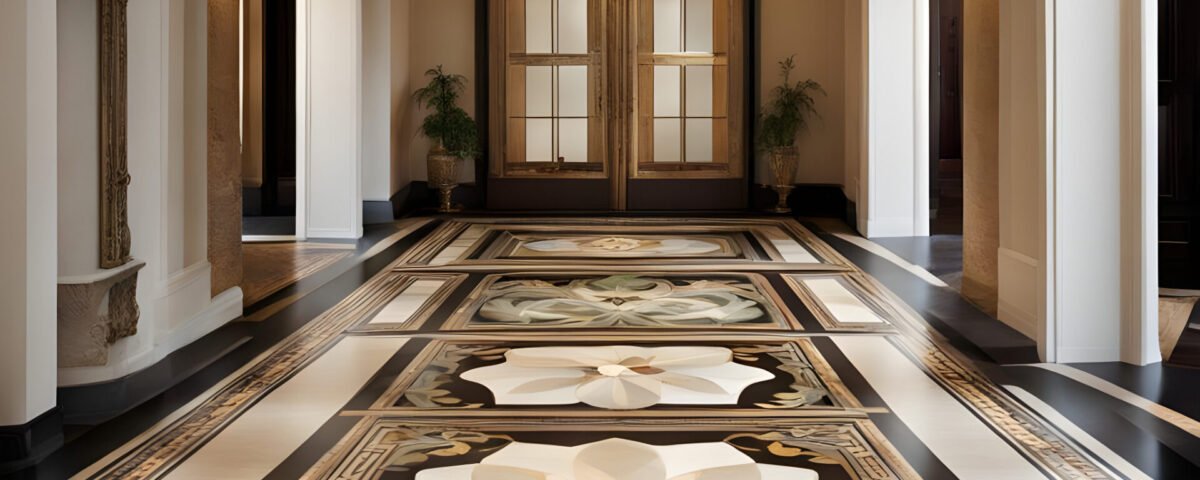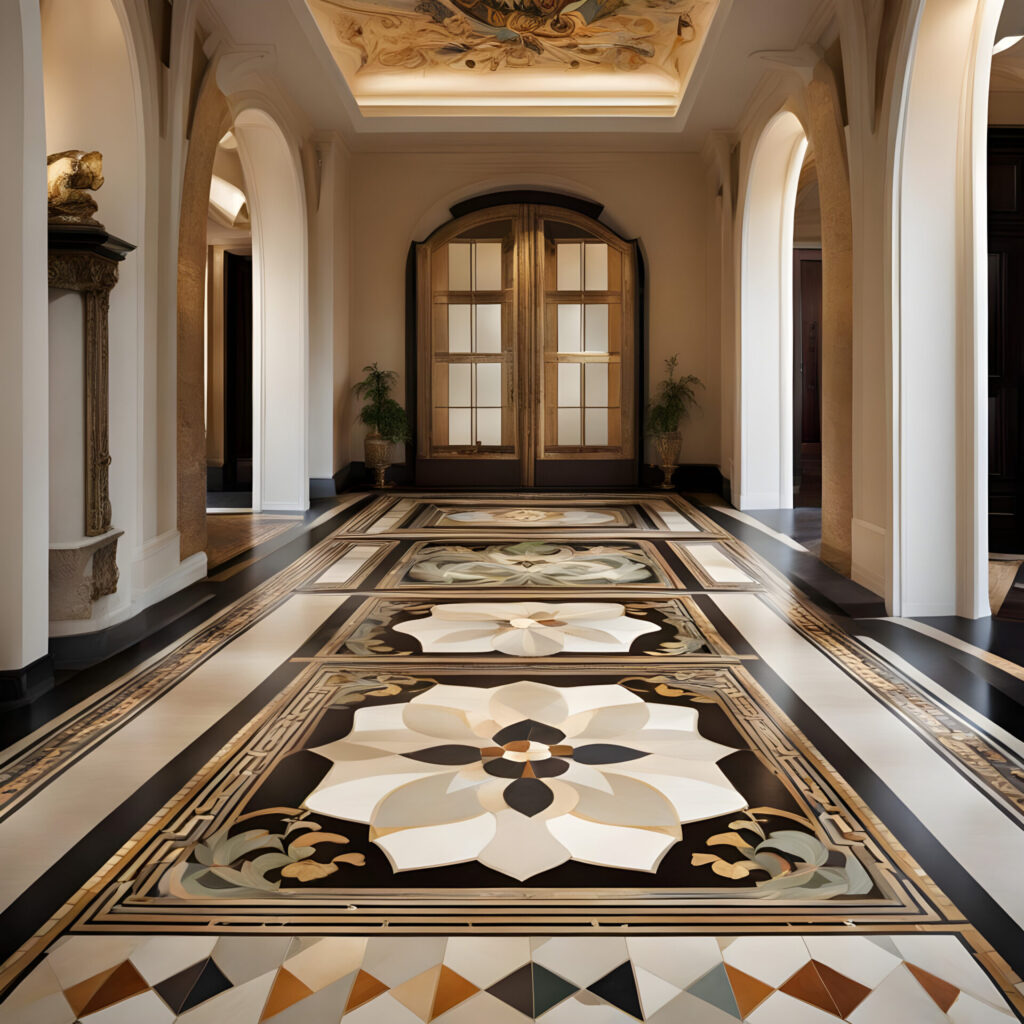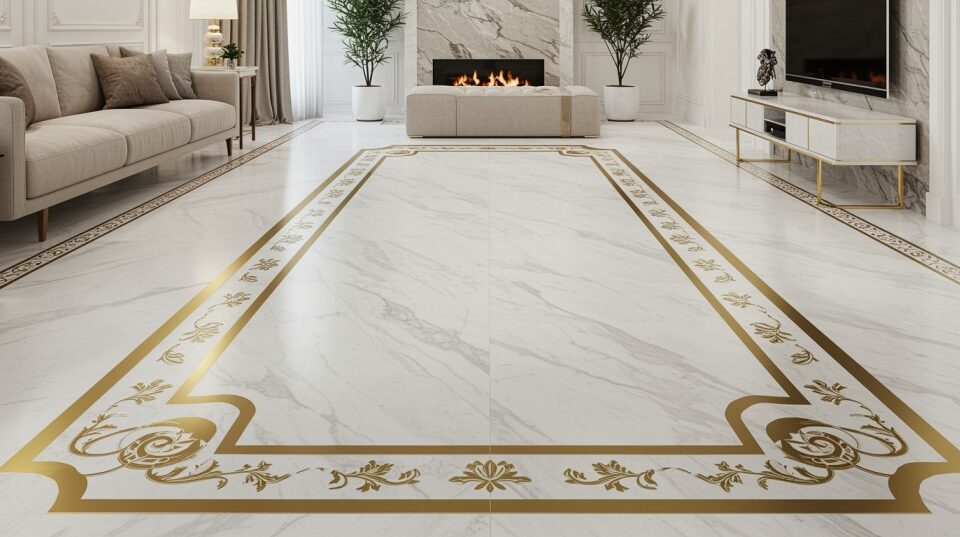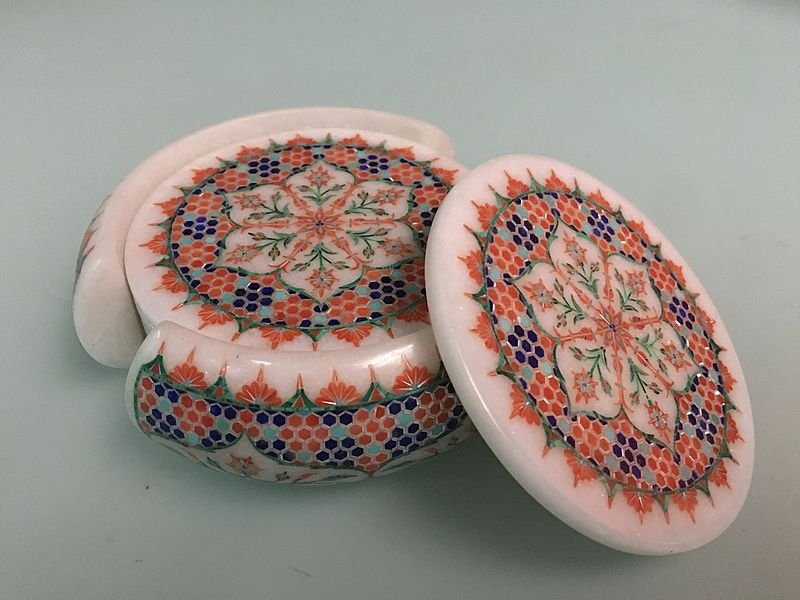The Artistry of Pietra Dura- Pietra Dura Designs/ Flooring

Pietra dura
Pietra dura, also known as pietre dure, and referred to as parchin kari or parchinkari in the Indian Subcontinent, is an artistic method involving the skillful arrangement of meticulously cut and polished colored stones to form intricate images. This technique is celebrated as a form of decorative art. The process involves precisely shaping the stones and then adhering them onto a base, creating a final composition where the seams between the stones are nearly imperceptible. To ensure stability, the stones are fitted together with interlocking grooves, similar to a puzzle, and a surrounding ‘frame’ secures the arrangement in place. A wide range of colored stones, including marbles as well as semiprecious and even precious gems, are employed. This artistic technique originated in 16th-century Rome and achieved its zenith of creativity in Florence. Artisans often create pietra dura pieces on bases made of green, white, or black marble. Although most pietra dura artworks result in entirely flat panels, some instances incorporate low-relief images, demonstrating a fusion with the realm of hardstone carving.
Pietra dura is an artistic technique involving the inlay of colored stones, including semiprecious gems, into a hard stone surface to create intricate and detailed designs. The term “pietra dura” translates from Italian as “hard stone,” which accurately describes the technique’s focus on working with various types of durable, polished stones.
This technique has a rich history and has been used in various cultures and periods, most notably during the Renaissance in Italy. It reached its peak of popularity during the 16th and 17th centuries. Italian workshops, particularly in cities like Florence, were renowned for their exceptional pietra dura craftsmanship.
The process involves carefully cutting and shaping various colored stones, such as lapis lazuli, jasper, onyx, agate, and other semiprecious gems, into thin, flat pieces. These pieces are then fitted into a meticulously carved recess in a larger stone, often marble, to create detailed pictures or intricate patterns. The stones are set closely together to form a seamless image, and the final piece is then highly polished to create a smooth and vibrant surface.
Pietra dura artwork often featured floral motifs, landscapes, mythological scenes, and intricate designs. These artworks were used to create decorative items such as tabletops, jewelry boxes, wall panels, and furniture embellishments.
While the popularity of pietra dura waned over time due to changes in artistic preferences and techniques, the art form still holds historical significance and is admired for its exquisite craftsmanship and attention to detail. It remains a testament to the skill and creativity of artisans from centuries past.
Connected arts and concepts associated with Pietra Dura include:
Pietre dure is the plural form in Italian, signifying “hard rocks” or hardstones; the singular, pietra dura, is also utilized in Italian. In the Italian language, but not in English, this term encompasses the entire spectrum of gem engraving and the artistic carving of three-dimensional objects from semi-precious stones, frequently from a single piece, as seen in the case of Chinese jade carving. English has traditionally employed the singular pietra dura primarily to describe multi-colored inlay work. However, a recent trend has emerged in Italian to use “pietre dure” to refer to the same concept, albeit not encompassing all the techniques it entails. Nevertheless, the title of a 2008 exhibit at the Metropolitan Museum of Art in New York, “Art of the Royal Court: Treasures in Pietre Dure from the Palaces of Europe,” adopted the complete Italian connotation of the term, possibly due to its higher brand recognition. The museum’s materials describe items like a lapis lazuli vase as instances of “hardstone carving (pietre dure).”
The Victoria & Albert Museum in London employs both variations on its website, but in its “Glossary,” it opts for “pietra dura” (“A method of inlaying colored marbles or semi-precious stones into a stone base, often in geometric or floral patterns…”), a resource seemingly not consulted by another webpage’s author, who defines “Pietre dure (from the Italian ‘hard stone’)” as the use of finely sliced colored stones meticulously matched to create either a pictorial scene or a regular design. The English term “Florentine mosaic” is also sometimes encountered, likely coined by the tourism industry. Italian Florentine artist Giovanni Montelatici (1864–1930) has gained international recognition for his superb pietra dura creations, which have been disseminated globally by tourists and collectors.
Art of the Royal Court pietre dure
Art of the Royal Court: Treasures in Pietre Dure from the Palaces of Europe” was an exhibition held at the Metropolitan Museum of Art in New York. The exhibition showcased exquisite artworks created using the pietre dure technique, which involves the intricate inlay of polished colored stones into hardstone surfaces to create intricate and detailed designs.
The title of the exhibition, “Art of the Royal Court,” suggests that the displayed pieces were associated with European royal courts, highlighting the prestigious nature of pietre dure creations. The artworks featured in the exhibition were likely sourced from various palaces across Europe, showcasing the opulent and decorative use of this technique within the context of royal collections.
The term “pietre dure” in the exhibition title emphasizes the Italian origin of the technique, which reached its height during the Renaissance in Italy. By using this term, the exhibition aligns itself with the historical and artistic heritage of pietre dure craftsmanship.
The exhibition likely aimed to provide visitors with a glimpse into the luxurious world of European royal courts and their appreciation for intricate craftsmanship and opulent design. It’s worth noting that exhibitions like this not only celebrate the artistic technique itself but also shed light on the cultural and historical contexts in which these artworks were created and appreciated.
Pietra dura distinguishes itself from mosaic art in that the component stones are generally larger and are shaped to suit their designated positions in the image, differing from the roughly uniform size and shape of mosaic tesserae. In pietra dura, the stones are not joined using grout, and pietra dura works often possess portability. It should not be mistaken for micromosaics, a mosaic variant that employs very small tesserae of the same size to craft images instead of decorative patterns, as seen in Byzantine icons and later in panels for furniture embedding.
For immobile inlay work on surfaces like walls, ceilings, and pavements that do not fit the mosaic definition, more appropriate terms include “intarsia” or, in specific cases, “Cosmatesque.” Likewise, for pieces that utilize larger stone or tile elements, “opus sectile” may be employed. Essentially, pietra dura represents stone marquetry. As a sophisticated manifestation of lapidary art, it shares close ties with jewelry artistry. Furthermore, it can be viewed as a branch of sculpture due to its potential for achieving three-dimensionality, akin to bas relief sculptures.
History
Historical Development – The art of pietra dura evolved from the ancient Roman technique known as opus sectile, which was primarily employed architecturally, adorning floors and walls with intricate designs encompassing both geometric patterns and figurative motifs. Throughout the Middle Ages, cosmatesque designs persisted on floors and small columns, particularly in tombs and altars, utilizing contrasting color inlays in geometric configurations. Byzantine art maintained the tradition of inlaid floors and extended its use to crafting small religious figures through hardstone inlays, as seen in instances like the Pala d’Oro in San Marco, Venice, although this piece primarily incorporated enamel work. The Italian Renaissance period witnessed a revival of this technique for creating images. The Florentine artists, who played a significant role in its refinement, perceived it as a form of “painting in stone.”
In its Florentine development, the technique initially bore the name “opere di commessi” (meaning “Fitted together works” in English). In 1588, Medici Grand Duke Ferdinando I of Tuscany established the Galleria di Lavori, now known as the Opificio delle pietre dure, with the aim of advancing this artistic form alongside other decorative crafts.
A diverse array of objects emerged from this technique’s mastery. Of notable acclaim were table tops, often among the larger creations. Smaller artifacts took the shape of medallions, cameos, wall plaques, inserts for doors and cabinets, bowls, jardinieres, garden embellishments, fountains, benches, and more. A favored approach was replicating existing paintings, frequently featuring human figures, exemplified by the likeness of Pope Clement VIII. These examples can be found in numerous museums. This artistry disseminated to other European centers of courtly art and retained its popularity well into the 19th century. Notably, Naples became a prominent hub for this craft. However, as the 20th century dawned, the technique faced decline, partly due to the influence of modernism, relegating the craft primarily to restoration work. In recent decades, there has been a revival, supported by government funding. Modern manifestations range from tourism-oriented keepsakes, including reproductions of religious subjects in the 19th-century style (especially prominent in Florence and Naples), to pieces inspired by or replicating older designs for opulent decorative purposes, to works reflecting contemporary artistic sensibilities.
Parchin kari
Parchin kari emerged as an artistic phenomenon by the early 17th century. Objects of smaller proportions, crafted by the Opificio delle pietre dure, had already spread extensively across Europe and had journeyed as far as the court of the Mughals in India by the eastern reaches of the same century. There, the technique was not only emulated but also reinterpreted to harmonize with indigenous aesthetics, resulting in its grandest manifestation within the confines of the Taj Mahal. In the context of Mughal India, pietra dura was referred to as “Parchin kari,” a term that directly translates to ‘inlay’ or ‘driven-in’ work.
The Taj Mahal’s prominence as a major tourist attraction has fostered a thriving industry centered around crafting pietra dura artifacts in Agra.
Famous Parchin kari Designs
While specific famous Parchin kari designs might not be as widely documented as some other artistic styles, the technique has been notably employed in creating intricate and exquisite inlay designs in various structures, particularly in Mughal architecture. One of the most renowned examples is, of course, the Taj Mahal in Agra, India, which stands as a pinnacle of Parchin kari craftsmanship. The Taj Mahal’s white marble façade is adorned with intricate floral and geometric motifs created through the inlay of semiprecious stones. The designs on the interior and exterior of the Taj Mahal showcase the mastery of Parchin kari, with elaborate floral patterns, arabesques, and calligraphy rendered in stone.
Apart from the Taj Mahal, Parchin kari can also be observed in other Mughal monuments and structures. Some other examples include:
- Agra Fort: This UNESCO World Heritage Site also features impressive Parchin kari designs on its marble surfaces, blending various colors of stones to create intricate patterns.
- Itimad-ud-Daulah’s Tomb: Often referred to as the “Baby Taj,” this tomb in Agra is another example of Mughal architecture adorned with delicate Parchin kari work.
- Red Fort, Delhi: While primarily known for its red sandstone architecture, the Red Fort in Delhi also incorporates Parchin kari elements in its interiors.
- Jahangir’s Tomb: Located in Lahore, Pakistan, this tomb features exquisite Parchin kari designs on its façade and interior, showcasing a blend of Persian and Indian artistic styles.
- Mughal Miniatures: While not architectural designs, Mughal miniature paintings also exhibit Parchin kari-like motifs in their intricate depictions of landscapes, gardens, and architectural elements.
It’s important to note that the term “Parchin kari” primarily applies to Mughal-era Indian art and architecture influenced by the pietra dura technique. The actual term “Parchin kari” might not be widely recognized outside of this context.
Inspire for Parchin kari Designs
Certainly, if you’re seeking inspiration for Parchin kari designs or similar intricate inlay work, you can draw ideas from a variety of sources. Here are some avenues to explore:
- Nature’s Beauty: Take inspiration from the natural world. Incorporate intricate renditions of flowers, leaves, vines, and animals into your designs. Emulate the symmetry and elegance found in botanical illustrations.
- Geometric Patterns: Explore the beauty of geometry. Experiment with symmetrical and asymmetrical patterns, interlocking shapes, and tessellations. Geometric designs can create a mesmerizing visual impact.
- Cultural Motifs: Draw from the rich cultural heritage of different regions. Incorporate motifs from Persian, Indian, Islamic, and other cultural traditions that commonly feature intricate inlay work.
- Architectural Elements: Look to the details of architectural elements such as arches, domes, and minarets for design inspiration. The repetition of arches and curves can create a harmonious composition.
- Islamic Calligraphy: If you’re open to expanding your design vocabulary, consider incorporating Islamic calligraphy. The elegant curves and lines of Arabic script can add a layer of depth and meaning to your designs.
- Mughal Miniatures: Study Mughal miniature paintings for their intricate depictions of landscapes, palaces, and gardens. Adapt these scenes into your Parchin kari designs, capturing their rich details.
- Gemstone Colors: Let the colors of semiprecious stones guide your palette. Experiment with combinations of vibrant and subtle hues to create dynamic contrasts in your designs.
- Personal Storytelling: Incorporate personal stories or narratives into your designs. Create scenes that convey emotions, historical events, or cultural symbolism.
- Contemporary Twist: Blend traditional Parchin kari techniques with a contemporary aesthetic. Experiment with unconventional materials or incorporate modern design elements.
- Mixed Media: Combine Parchin kari with other artistic mediums like painting, ceramics, or woodwork to create multidimensional pieces.
- Abstract Interpretations: Play with abstract interpretations of traditional motifs. Simplify complex patterns while retaining their essence.
- Travel and Exploration: If feasible, travel to places with a rich history of inlay work, such as India, Turkey, and Italy. Immerse yourself in local art and architecture for firsthand inspiration.
Remember, Parchin kari designs are characterized by their intricate details and precision. Sketch, experiment with color swatches, and consider using digital tools to visualize your ideas before translating them into your chosen medium.
Tilohandicrafts” appears to be a company specializing in Marble Inlay Flooring and Pietra Dura Flooring. Marble inlay and Pietra Dura are intricate and artistic forms of decoration that involve the use of finely cut and polished colored stones to create beautiful patterns, images, and designs on surfaces like flooring, tabletops, and other decorative objects.





